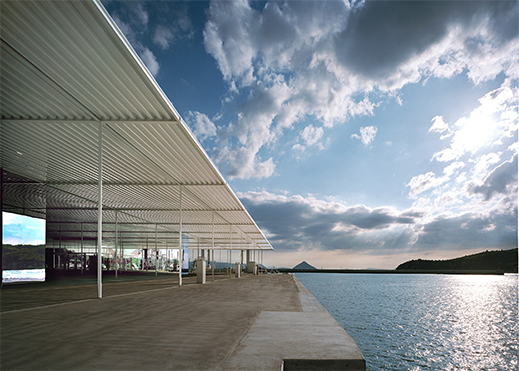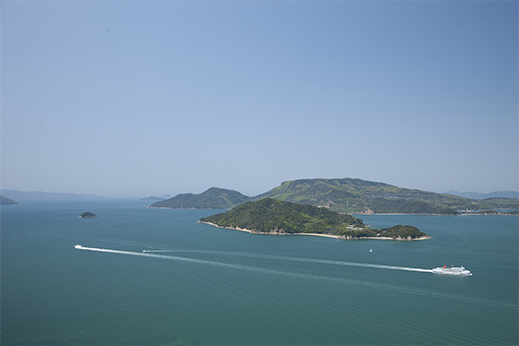 |
Focus features two in-depth reviews each month of fine art, architecture and design exhibitions and events at art museums, galleries and alternative spaces around Japan. The contributors are non-Japanese residents of Japan. |
|
|
 |
 |
 |
Island Time: Art-Hopping in Setouchi
Colin Smith |
 |
Yayoi Kusama, Red Pumpkin (2006). One of many works you can go inside. Photo by Naoshima Miyanoura Port Square Photo / Daisuke Aochi |
"It's not a view, it's an experience. One is meant to wander…" In his 1971 travel memoir The Inland Sea, Donald Richie described Itsukushima Shrine in Hiroshima this way, comparing it to Venice for its labyrinthine, aquatic quality. These words could also describe a group of islands in that same sea, where the fourth edition of the Setouchi Triennale is happening this year. Several are home year-round to a wealth of contemporary art and architecture, much of it experiential and ideal for wandering.
Venice is home to the Biennale on which so many art festivals worldwide are modeled. In Japan there are several prominent triennials, but the Setouchi Triennale differs greatly from the more prevalent type of urban art festival. Setouchi refers to the Seto Inland Sea, the hundreds of islands dotting it, and the encircling coasts of Honshu, Shikoku, and Kyushu; the Triennale sprawls across 12 of these islands and two ports on Honshu and Shikoku. From these ports (Uno in Okayama Prefecture and Takamatsu in Kagawa Prefecture) depart ferries to larger participating islands, while speedboats serve smaller islands. On most islands, you get around on foot or rented bicycle. Trips between art sites -- scenic boat rides, meandering rural cycling, walks through maze-like villages -- are as full of discoveries as the art. "One is meant to wander."
 |
|
SANAA, Marine Station Naoshima (2006), © Kazuyo Sejima + Ryue Nishizawa. Visitors from Honshu arrive at this ferry terminal. |
The Triennale was launched in 2010, but the project of bringing works by high-profile contemporary artists and architects to this rustic region and attracting visitors from far and wide goes back decades. It began on Naoshima, where the local mayor joined forces with the head of educational-services corporation Benesse to create a cultural center in the picturesque but aging and depopulated island community. Benesse Art Site Naoshima -- today the hub of an ever-expanding web of art venues, site-specific installations, and related tourist infrastructure -- contains several museums, including the Tadao Ando-designed Chichu Art Museum (as of recently, reservations required). Chichu literally means "in the earth" and the museum is subterranean, but lit by ever-changing natural light. It permanently exhibits the work of just three artists -- Walter de Maria, Claude Monet, and James Turrell -- but each exhibit is immersive, the art, architecture and light inseparable, and re-emerging from the museum feels like leaving a dark theater after a hypnotic experimental film. This becomes a familiar sensation on the islands, there are so many womb-like, meditative spaces combining art, architecture, and the surrounding natural environment. At Minamidera, also designed by Ando for art by Turrell, grope your way into the pitch-black space and wait until your eyes adjust (no spoilers). Kadoya is a two-centuries-old house with a dark interior containing Tatsuo Miyajima's mesmerizing digital-Zen installation Sea of Time '98. Beneath Go'o Shrine, another Edo-period structure, restored with spare elegance by Hiroshi Sugimoto, is a narrow stone passageway to a dank underground chamber with a tiny window on the sunlit sea outside. When you return to the outside world, it's more beautiful than ever. All these are part of the Naoshima Art House Project, in which artists are given old houses or other sites to create installations.
 |
|
The Seto Inland Sea. Photo by Osamu Nakamura |
Two other islands, Teshima and Inujima, have permanent venues operated by Benesse Holdings and the Fukutake Foundation. Electrically assisted bicycles are recommended on Teshima: there are ups and downs on the way to the Teshima Art Museum, a biomorphic space-pod by Ryue Nishizawa (one half of the architecture team SANAA) amid trees and terraced rice fields, with apertures for natural light and wind. It houses an entrancing installation by Rei Naito featuring droplets and streams of seemingly conscious water. Like the clouds, trees and birds above the apertures, visitors become part of the work. A reverent hush prevails, but visitor behavior varies widely -- ambling, meditating, hardcore floor-sleeping. No photography, as at most venues, and precious few devices.
By contrast, the interior of Christian Boltanski's nearby Les archives du cœur is dark, angular, and overpowering. Heartbeats recorded by past participants play at high volume, changing persons at regular intervals; lightbulbs flash in time, and the person's data (name, location, date of recording) appear. You can record your own heartbeat for a fee and add it to the collection. Here, too, art is not "viewed" but experienced, offering a new outlook on this finite life.
 |
|
Kenji Yanobe, The Star ANGER (2012), on Shodoshima. Photo by Kimito Takahashi |
On Inujima (population 30, but with many more charmingly decrepit buildings) the main attraction is the Inujima Seirensho Museum, a former copper refinery redesigned by Hiroshi Sambuichi with its crumbling 1909 brick structure carefully preserved, its dark interior containing a gripping sequence of installations by Yukinori Yanagi on the theme of novelist Yukio Mishima. The latter, whose despair with modern Japan famously led him to commit public seppuku, fits this gorgeously ruined site nicely.
|
 |
|
|
|
Gregor Schneider, Completely Insulated Death Room (1989). His Unknown Work 2019 will appear on Ogijima this summer. |
Naoshima, Teshima and Inujima are musts, at least for first-time visitors, and touring them easily takes two days. There are new artworks and various projects on several other islands, which people with more time, or who have already done the big three, will want to visit. A Triennale staff member personally recommended Megijima (lit. "woman-tree-island"), a.k.a. Onigashima, isle of demons from the Momotaro folktale, who are said to inhabit caves at its summit. Its nearby sibling Ogijima ("man-tree-island") is a success story for the Triennale, which exhibited art in the island's empty public school in 2013, when the student body dwindled from a handful to zero. This art helped attract families back to the island, which now has a reopened school and a rebounding population -- though still probably more cats than people.
Visiting the smaller islands requires planning -- for example, Megijima and Ogijima are easily reachable from Takamatsu, but there is only one boat to and from Naoshima per day. Another cluster of islands to the west, slated to participate in the Triennale's autumn segment (28 September - 4 November), is accessible from Kurashiki and several Shikoku ports, but their marine transport network appears separate from that of the eastern islands. That being said, getting to these sites is half the fun (unless you are prone to severe seasickness), and works and spaces that plunge you into otherworldly stillness after your train, boat and bicycle rides give the visit a pilgrimage-like quality.
 |
|
Yodogawa Technique, Black Porgy in Uno (2010). Photo by Osamu Nakamura. The unit makes visually fun-filled, environmentally thought-provoking garbage sculpture.
|
The 2019 Triennale theme is "Restoration of the Sea," and its goal of "revitalizing the island communities that once thrived in this beautiful natural environment," like the ongoing Benesse project, is being realized in a nicely balanced way. Naoshima is an internationally noted tourist attraction, but the lesser-known islands remain rugged. Lately, however, they are drawing not only visitors but also more full-time residents and entrepreneurs captivated with island life. Cafés, healthy restaurants and stylish inns blend in with the old-school townscape.
While the Seto Inland Sea art islands are always good to visit, the helpful English-speaking staff, increased signage and (nearly) all-entry passport make the Triennale an ideal time to go, even if you only make it to the major spots. Advance planning is required, but once on an island, time slows and the urban hustle seems like a dream -- perfect for taking in art and architecture that is often mind-altering and revelatory.
 |
|
Tanya Preminger, Stratums (2013), on Shamijima. This interactive land-art piece contrasts with the white, linear expanse of the nearby Seto Ohashi Bridge. Photo by Kimito Takahashi
|
All images courtesy of the Setouchi Triennale Executive Committee. |
 |
 |
Colin Smith
Colin Smith is a translator and writer and a long-term resident of Osaka. His published writing includes the travel guide Getting Around Kyoto and Nara (Tuttle, 2015), and his translations, primarily on Japanese art, have appeared in From Postwar to Postmodern: Art in Japan 1945-1989: Primary Documents (MoMA Primary Documents, 2012) and many museum and gallery publications in Japan. |
|
 |
|